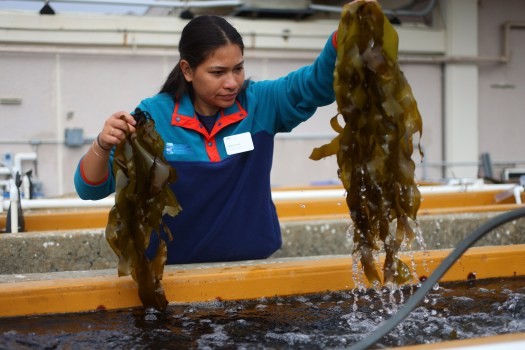
In the fog-shrouded waters off the Northern California coast, a team of dedicated marine biologists is embarking on a mission to resurrect the region's once-thriving kelp forests. These underwater ecosystems, which nearly vanished a decade ago, are now showing signs of revival thanks to innovative restoration efforts.
A Glimmer of Hope in Bodega Bay
At the UC Davis Marine Laboratory near Bodega Bay, marine biologist Julieta Gomez and her team are nurturing the future of kelp forests. Their method involves growing bull kelp starts on spools of twine, which are then transplanted to the ocean floor. The results have been encouraging, with over 100 juvenile kelp stipes appearing within a month of placement.
"They're looking amazing," Gomez remarked, her enthusiasm evident as she examined the tiny kelp specimens.
The Kelp Forest Collapse
The need for such interventions stems from a catastrophic event in 2014 when a marine heat wave, dubbed "the blob," triggered a cascade of ecological changes. This, combined with the absence of key predators, led to an explosion in the purple sea urchin population. These voracious eaters decimated more than 90% of the bull kelp forests along Northern California's coastline.
A Multi-Pronged Approach
The restoration efforts involve multiple strategies:
- Transplanting kelp starts grown in the laboratory
- Commercial divers removing hundreds of thousands of purple urchins
- Scientists releasing millions of kelp spores directly into the water
While the experiments are currently small-scale, covering only a few acres each, the results are promising. In one cove in Sonoma County, a canopy of bull kelp has shown modest expansion over the summer.
Challenges and Obstacles
Despite these early successes, significant challenges remain. The sheer number of purple urchins far exceeds what divers can manually remove. Additionally, the absence of natural predators like sunflower stars (locally extinct due to disease) and sea otters (hunted to extinction in the 19th century) complicates the restoration process.
Joshua Smith, a research scientist at the Monterey Bay Aquarium, noted, "It's a lot of work to put people in the water and remove enough sea urchins to facilitate recovery."
The Importance of Kelp Forests
Kelp forests are not just beautiful underwater landscapes; they serve critical ecological functions:
- Providing habitat for diverse marine life
- Supporting commercial fisheries
- Storing carbon dioxide, helping to mitigate climate change
- Protecting coastlines from erosion
A Global Effort
The work in Northern California is part of a broader, global initiative to restore kelp forests. Similar projects are underway in Baja California, Southern California, Oregon, and Washington's Puget Sound. Scientists are increasingly recognizing the importance of these underwater forests and their potential role in climate change mitigation.
Looking to the Future
While the current efforts show promise, the road to full restoration is long and uncertain. The reintroduction of natural predators like sea otters remains a controversial topic, with potential ecological benefits weighed against concerns from commercial fisheries.
For now, as Brent Hughes, a professor of biology at Sonoma State University involved in the restoration efforts, puts it, "Humans are the most efficient solution." The dedication of scientists, divers, and volunteers offers hope for the return of these magnificent underwater forests to the Northern California coast.